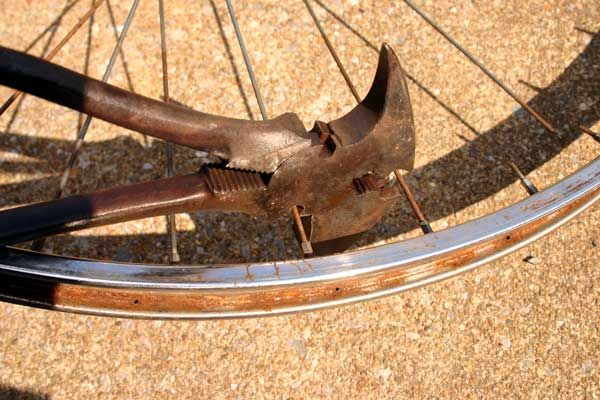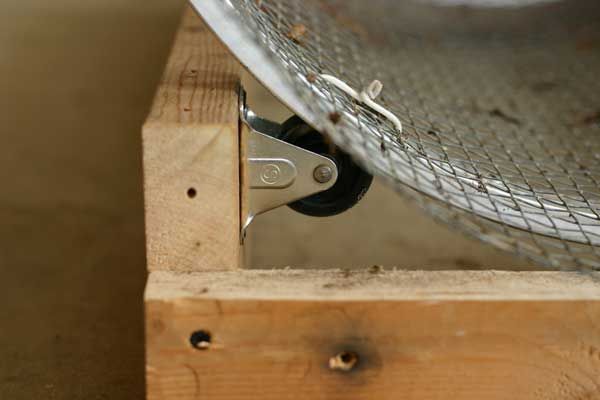How To Become More Self-Sufficient Without Starting a Full-Blown Farm…
Want to start preserving your harvest, making your own soap, or building a backyard root cellar — but not sure where to begin? “Homesteading Advice” gives you instant lifetime access to 35+ practical homesteading books on food preservation, veggie gardening, DIY natural cleaning products (save over $250 per year with this skill alone), brewing, off-grid energy, and a whole lot more…
Click Here To Check It Out Now!
Here’s how to build a trommel (rotary screen) for sifting compost or shredded leaves. The purpose of sifting is to separate coarse unfinished compost materials from the finished product or to separate out trash and debris from other organic materials before use in the garden.
My city has trucks that go around sucking up all the leaves in the fall. These leaves are then placed in a huge pile and allowed to decompose. I can go get decomposed leaves from them as needed but they often contain trash and rocks that need removed so I’m planning to use this trommel to sift that material as well as compost. Sifting also makes organic materials appear more uniform which is desirable if you are using them as a top dressing or mulch.
Step 1: Materials Needed…
– 1/2 inch hardware cloth…

– two large surplus bicycle rims…

– 4 rollers and bolts to attach…

– a little over 8 feet of dimensional lumber…

– misc. wires for connecting the hardware cloth to the rims…

Step 2: Remove The Spokes From The Rims…

The fastest way is to cut them if you have some really strong wire or chain cutters. I used a really ancient fencing tool and that worked great!
Step 3: Cut The Hardware Cloth To Fit Inside The Bike Rims…

My rims (inside) measured about 21.4 inches in diameter so multiplying 21.4 x pi gives me a 67.2 inch minimum length. Add about 4 inches for overlap of the seam and cut at about 71 inches. I used standard 36 inch width hardware cloth.
Step 4: Attach The Hardware Cloth To The Rims…




Place the hardware cloth inside the rims and attach with wires through the spoke holes. I used plastic coated #14 household electrical wire. To fasten the seam of the tube I used #18 wire. (Be careful not to over tighten the wire or the wire will break.) Make sure the wire on the outside of the rim is lying flat so that the rollers don’t bump over it.
Step 5: Build The Roller Box…



This is a pretty simple structure so I won’t go into a lot of detail. I used 2×6 lumber because I happened to have several short pieces on hand that were just the right size, but 2x4s should work fine too and would be a little lighter.
My side pieces are 34 inches long and the ends are 19 inches long which leaves a gap of 16 inches in the middle. Note that one end needs to be ripped down 2.5 inches lower than the other because the drum needs to overrun the box slightly so that the coarse materials spill out of the drum. Since I used 2x6s (1.5 x 5.5) my spillway end piece was 3 inches wide. If you are using 2x4s (1.5×3.5) Then your end piece would need to be one inch wide.
Note that these dimensions assume that you are using the same diameter rims that I used. If you use different size rims then obviously you will need to modify the dimensions to accommodate your particular arc.
To align your rollers place the finished drum onto the roller box and then mark your roller positions. You may want to attach the rollers first with simple drywall screws (as I did) to test their positioning and then drill and bolt them later once you are happy with the alignment.
Step 6: Done…

Once the roller box is complete you are ready to try the trommel out. Mine fits perfectly on top of my wheelbarrow which is handy so you may want to take your wheelbarrow size into account when planning your dimensions. You could also place the trommel on sawhorses or make permanent legs if you prefer. Just make sure the output side of the trommel is slightly downhill from the input side.

If you have a large quantity of material to screen you may want to find a buddy who will keep turning the drum while you continue shoveling material. If you are working alone then you will have to load a couple shovelfuls into the drum and then give it a few turns yourself before loading more compost.
Step 7: One Final Detail…
Once I tried the trommel out I discovered that if you pile a couple shovelfuls of material in the uphill end of the drum and then turn it yourself some of the coarse material tends to spill uphill and out of the drum.


To solve this problem I made a simple partition out of plywood to prevent this from happening. I don’t think this would be a problem when operating the trommel with a buddy since the material wouldn’t build up into such a large pile as you have when working alone (via Instructables).
If you like this idea, be sure to share it with your friends and inspire someone you know. Anything becomes possible with just a little inspiration…
